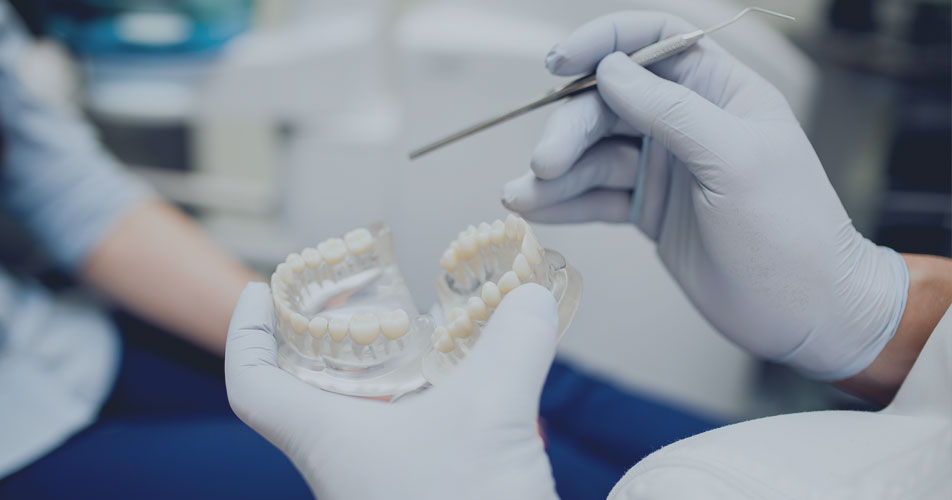Prosthetic and Implants
Dental prosthetics also known as prosthodontics is a branch of dentistry that deals with deficient and missing teeth. The specialist will improve the aesthetic appearance of your teeth and their function and provide you with a better quality of life.
FIXED PROSTHETICS


Crowns are prosthetics which imitates natural teeth in colour, size, and shape and make up the lost tooth structure. They are glued to the tooth and look like caps.
You will need crowns when:
- there is a danger of breaking the part of the tooth, or there are some bigger fillings
- due to a high caries lesion or breakage, a big part of the tooth is lost
- you are not satisfied with the position and look of your teeth
- as the result of ageing, teeth are broken away naturally
- the tooth is reinforced with fibreglass pin and extracted from its nerves – devitalized
THE PROCESS
After the specialist examines you, he will explain the treatment, make a plan and determined the teeth where the crowns are placed. He will then put you under local anaesthesia and shape the teeth. After he takes an impression from the opposite jaw, he will make the print and send it to the lab.
According to the materials and case from which the crowns are created, the dental technician prepares one rehearsal or more if needed and determines a colour of it, consulting first with the doctor and the patient.

AVAILABLE TYPE OF CROWNS

![]()
Ceramic Metal Crowns
Most commonly and classically used crown is the metal-ceramic one, thanks to its acceptable aesthetics and excellent mechanical properties. The alloy layer is the base of the crown, and that is where the ceramic is placed. But there are a few disadvantages of these crowns. For example, an allergy to alloys is first and the second can be noticed during the gums’ withdrawal when you can see the metal edge.
Ceramic Metal – Free Crowns
In order to achieve minimally invasive technique or high tooth aesthetics in its shape, it is used in the frontal region. Because of the strong chewing forces, it is not suitable for lateral areas, since there is no base that gives strength and firmness.
![]()
Titanium – Ceramic Crowns
Titanium has been used for many years in both dental implant technology and joint medical replacement. The specialists can give you the aesthetics of high-quality material with porcelain fused to titanium bridges and crowns. Without needing to remove the fixed prosthesis, titanium will allow you to see the chamber of pulp under the restoration that is cemented.
Titanium will prevent irritation to the pulp because of its low thermal conductivity. The rigidity and strength of this material are comparable to other high noble alloys that are used commonly in stomatology.
![]()
Zirconium Oxide Crowns
Zirconium is the most significant discovery and relatively new material in dental medicine. It is an unfavourable base for plaque build-up which slows down gingival recession and improves oral hygiene care. Zirconium is weak electricity and heat conductor that minimizes teeth oversensitivity, doesn’t respond to surrounding tissues, and it’s biocompatible.
It doesn’t have a metal base, and without getting fractured, it can bear the lateral region’s chewing forces.
![]()
Bridges
A dental bridge is a type of crown that the specialists use to replace one lost tooth or more. It consists of two or more crowns for the teeth on gap’s each side. A three-tooth implant is the most common and simplest of them. If you don’t fill the spaces between the teeth, there is a big chance that will others begins to move which can cause paradentosis and you can lose proper bite.
ALL-ON-FOUR DENTAL IMPLANTS

![]()
Acrylic or Composite All-On-4 Dental Implants
This is the traditional method. It uses a framework made of metal, most frequently titanium, on top of which the acrylic denture is affixed. These are still durable and if something goes wrong, easily fixable. While the individual teeth might chip or come loose, after a quick adjustment, they are as good as new.
They can also be stained easily, but that problem can easily be fixed with regular cleaning and maintenance. This is also the cheapest option, but despite that, the denture can be as durable as any other alternative as long as it is properly maintained.
![]()
Porcelain All-On-4 Dental Implants
Porcelain implants are the most aesthetically pleasing, but they are more expensive. They also use a metal framework, but instead of acrylic or composite, the teeth themselves are made of porcelain. These will give the most lifelike results, and they will not stain in time, either.
They are made to last a lifetime, and with normal use, you’ll never see them chip. Despite their durability, if something does go wrong, repair and maintenance are also quick and easy. So, while they might be more expensive, they can be worth it in the end.
STRUGGLE WITH THE SAME PROBLEM?
